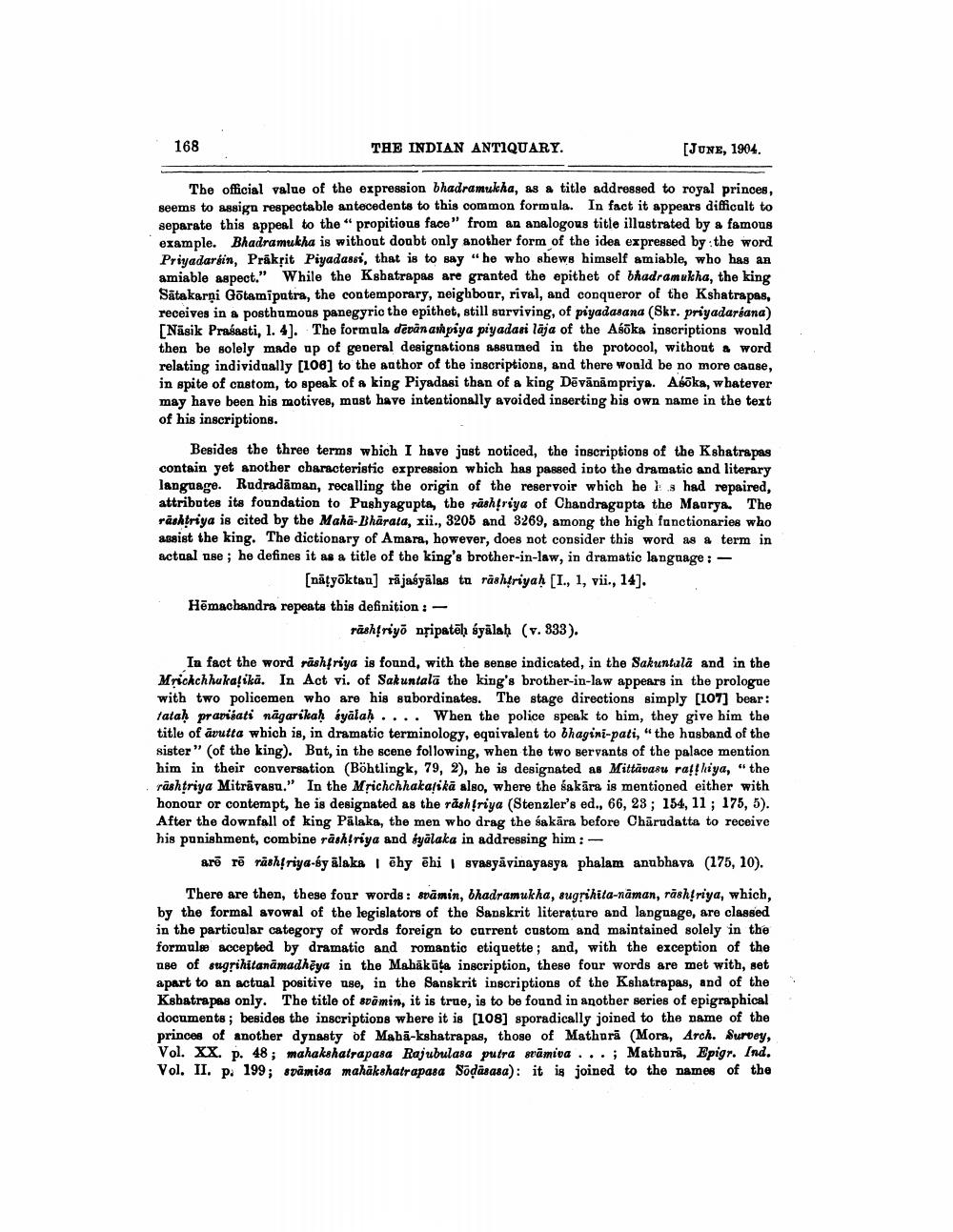________________
168
THE INDIAN ANTIQUARY.
[JUNE, 1904.
The official value of the expression bhadramukha, as a title addressed to royal princes, seems to assign respectable antecedents to this common formula. In fact it appears difficult to separate this appeal to the " propitious face" from an analogous title illustrated by a famous example. Bhadramukha is without doubt only another form of the idea expressed by the word Priyadarsin, Prakrit Piyadassi, that is to say "he who shews himself amiable, who has an amiable aspect." While the Kshatrapas are granted the epithet of bhadramukha, the king Satakarni Gotamiputra, the contemporary, neighbour, rival, and conqueror of the Kshatrapas, receives in a posthumous panegyric the epithet, still surviving, of piyadasana (Skr. priyadarsana) [Nasik Prasasti, 1. 4]. The formula devanampiya piyadasi laja of the Asoka inscriptions would then be solely made up of general designations assumed in the protocol, without a word relating individually [108] to the author of the inscriptions, and there would be no more cause, in spite of custom, to speak of a king Piyadasi than of a king Devanāmpriya. Asōka, whatever may have been his motives, must have intentionally avoided inserting his own name in the text of his inscriptions.
Besides the three terms which I have just noticed, the inscriptions of the Kshatrapas contain yet another characteristic expression which has passed into the dramatic and literary language. Rudradaman, recalling the origin of the reservoir which he s had repaired, attributes its foundation to Pushyagupta, the rashtriya of Chandragupta the Maurya. The rashtriya is cited by the Maha-Bharata, xii., 3205 and 3269, among the high functionaries who assist the king. The dictionary of Amara, however, does not consider this word as a term in actual use; he defines it as a title of the king's brother-in-law, in dramatic language: - [nätyöktau] rajasyalas tu rashtriyah [I., 1, vii., 14]. Hemachandra repeats this definition: -
rashtriyō nṛipateḥ śyalaḥ (v. 333).
In fact the word rashtriya is found, with the sense indicated, in the Sakuntala and in the Mrichchhukatika. In Act vi. of Sakuntala the king's brother-in-law appears in the prologue with two policemen who are his subordinates. The stage directions simply [107] bear: tataḥ pravisati nagarikaḥ śyalaḥ.... When the police speak to him, they give him the title of avutta which is, in dramatic terminology, equivalent to bhagini-pati, "the husband of the sister" (of the king). But, in the scene following, when the two servants of the palace mention him in their conversation (Böhtlingk, 79, 2), he is designated as Mittavasu raṭṭhiya, "the rashtriya Mitrāvasu." In the Mrichchhakatika also, where the śakara is mentioned either with honour or contempt, he is designated as the rashtriya (Stenzler's ed., 66, 23; 154, 11; 175, 5). After the downfall of king Palaka, the men who drag the sakara before Charudatta to receive his punishment, combine rashtriya and éyalaka in addressing him :
are re rashtriya-sy alaka ehy ehi | svasyavinayasya phalam anubhava (175, 10).
There are then, these four words: svamin, bhadramukha, sugṛihita-nāman, rāshtriya, which, by the formal avowal of the legislators of the Sanskrit literature and language, are classed in the particular category of words foreign to current custom and maintained solely in the formule accepted by dramatic and romantic etiquette; and, with the exception of the use of sugrihitanamadheya in the Mahakūta inscription, these four words are met with, set apart to an actual positive use, in the Sanskrit inscriptions of the Kshatrapas, and of the Kshatrapas only. The title of svamin, it is true, is to be found in another series of epigraphical documents; besides the inscriptions where it is [108] sporadically joined to the name of the princes of another dynasty of Maha-kshatrapas, those of Mathura (Mora, Arch. Survey, Vol. XX. p. 48; mahakshatrapasa Rajubulasa putra svāmiva...; Mathura, Epigr. Ind. Vol. II. p. 199; svamisa mahakshatrapasa Sodasasa): it is joined to the names of the




